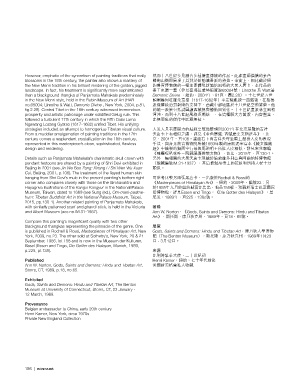Page 188 - Bonhams Auction Images of Devotion Oct. 2 2018
P. 188
However, emphatic of the syncretism of painting traditions that really 然而十八世紀多見融合多種繪畫傳統的作品。此處畫師描繪的金色
blossoms in the 18th century, the painter also shows a mastery of 嶙峋山巒即展現了其對於新勉塘畫派的熟捻。事實上,相比藏於紐
the New Menri tradition in his brilliant rendering of the golden, jagged 約魯賓博物館的一幅主要體現新勉塘風格的大黑天唐卡,本作品的
landscape. In fact, his treatment is significantly more sophisticated 畫工更勝一籌(參見喜瑪拉雅藝術資源65004號;Linrothe 及 Watt著
than a blackground thangka of Panjarnata Mahakala predominately Demonic Divine ,紐約,2004年,81頁,圖2.28)。十七世紀五世
in the New Menri style, held in the Rubin Museum of Art (HAR 賴喇嘛阿旺羅桑嘉措(1617-1682年)平定騷亂統一西藏後,在格魯
no.65004; Linrothe & Watt, Demonic Divine , New York, 2004, p.81, 派強權統治對藝術的支持下,西藏中部地區於十八世紀空前繁榮。他
fig.2.28). Central Tibet in the 18th century witnessed tremendous 的統一政策包括試圖讓西藏視覺藝術同質化。十七世紀畫派林立風格
prosperity and artistic patronage under solidified Gelug rule. This 渾沌,而到十八世紀風格逐漸統一,在這幅既大方簡潔、內容豐富、
followed a turbulent 17th century in which the Fifth Dalai Lama 毫無瑕疵的傑作中展露無疑。
Ngawang Lozang Gyatso (1617-1682) unified Tibet. His unifying
strategies included an attempt to homogenize Tibetan visual culture. 大黑天具有震攝力的結綵皇冠骷髏頭與2001年在北京展覽的吉祥
From a muddier amalgamation of painting traditions in the 17th 天唐卡上有相似之處,詳見《金色寶藏: 西藏歷史文物選萃》,北
century comes a resplendent crystallization in the 18th century, 京,2001年,頁106。畫面右下角吉祥天母坐騎上懸掛人皮的表現
represented in this masterpiece’s clean, sophisticated, flawless 手法,與台北故宮博物院所藏1669年製的康熙泥金寫本《藏文龍藏
design and rendering. 經》中繪製的獅面空行母與馬頭明王所批人皮相似,詳見宋兆霖編
《唵嘛呢叭咪吽-院藏藏傳佛教文物》,台北,2015年,頁130-1。
Details such as Panjarnata Mahakala’s charismatic skull crown with 另外一幅相關的大黑天唐卡現藏於倫敦維多利亞與阿爾伯特博物館
pendant festoons are shared by a painting of Shri Devi exhibited in (館藏編號IM.31-1937),其肩披勉帛帶上的花紋和所持天杖十分
Beijing in 2001 (see Jin We Bao Zang: Xizang Li Shi Wen Wu Xuan 類似。
Cui, Beijing, 2001, p.106). The treatment of the flayed human skin
hanging from Shri Devi’s mule in the present painting’s bottom right 可參考比較另兩張黑唐卡,一出版於Rochell & Rossi的
corner also compares closely with those on the Simhavaktra and 《Masterpieces of Himalayan Art》,紐約,2009年,編號23;另一
Hayagriva illustrations of the Kangxi Kangyur in the National Palace 於1985年九月於紐約蘇富比售出,拍品158號,現藏於瑞士巴塞爾民
Museum, Taiwan, dated to 1669 (see Sung (ed.), Om-mani-padme- 俗博物館,詳見Essen and Tingo,《Die Gotter des Hialayan》,慕
hum: Tibetan Buddhist Art in the National Palace Museum, Taipei, 尼黑,1989年,頁225,138c號。
2015, pp.130-1). Another related painting of Panjarnata Mahakala,
with similarly patterned scarf and ghandi stick, is held in the Victoria 著錄
and Albert Museum (acc.no.IM.31-1937). Ann W. Norton,《Gods, Saints and Demons: Hindu and Tibetan
Art》,斯托斯,康乃狄克州,1989年,頁18,65號。
Compare this painting’s magnificent quality with two other
blackground thangkas representing the pinnacle of the genre. One 展覽
is published in Rochell & Rossi, Masterpieces of Himalayan Art, New Gods, Saints and Demons: Hindu and Tibetan Art,康乃狄大學博物
York, 2009, no.23. The other sold at Sotheby’s, New York, 20 & 21 館(The Benton Museum),斯托斯,康乃狄克州,1989年1月23
September, 1985, lot 158 and is now in the Museum der Kulturen, 日 - 3月12日。
Basel (Essen and Tingo, Die Gotter des Hialayan, Munich, 1989,
p.225, pl.138). 來源
比利時駐華大使,二十世紀初
Published Henri Kamer,紐約,七十年代前後
Ann W. Norton, Gods, Saints and Demons: Hindu and Tibetan Art, 美國新英格蘭私人收藏
Storrs, CT, 1989, p.18, no.65.
Exhibited
Gods, Saints and Demons: Hindu and Tibetan Art, The Benton
Museum at University of Connecticut, Storrs, CT, 23 January -
12 March, 1989.
Provenance
Belgian ambassador to China, early 20th century
Henri Kamer, New York, circa 1970s
Private New England Collection
186 | BONHAMS

